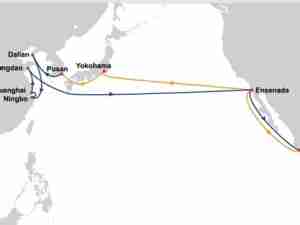Key insights:
- Asia-US ocean rates fell more than 6% to both coasts this week, with West Coast rates now 22% below the mid-September peak. As delays make it unlikely that new orders will arrive in time for the holidays, the rate drops indicate that the peak season rush is easing.
- Ocean delays – driven by import-clogged container yards and a shortage of trucks and warehouses to move them away – are sending some importers to air cargo as an alternative. Freightos.com marketplace data show that the share of bookings on the platform that move by air has more than doubled since June when congestion at LA/Long Beach and elsewhere started to build.
Asia-US rates:
- Asia-US West Coast prices (FBX01 Daily) decreased 7% to $16,145/FEU. This rate is 320% higher than the same time last year.
- Asia-US East Coast prices (FBX03 Daily) fell 6% to $19,451/FEU, and are 316% higher than rates for this week last year.
Analysis
Delays in ocean logistics make holiday season orders placed now unlikely to arrive in time. Those delays, along with some constraints to the supply of goods due to energy shortages in China drove an easing in transpacific rates this week with Asia-US rates falling by more than 6% to both coasts and Asia-US West Coast prices now 22% below the mid-September peak.
But port congestion at LA/Long Beach – which continues to cause delays and contribute to still extremely elevated rates by sapping capacity – persists. A lack of space for arriving containers at the ports has emerged as the main choke point, slowing how quickly ships can be unloaded and keeping 79 ships – a new record – waiting in the bay.
Shortages of trucking and warehouse capacity to move containers away are big contributors to the backup. In trucking there’s a shortage of both drivers and chassis, exacerbated by the lack of space at warehouses where empty containers often get stored on chassis when there’s no place to stack them. And to complete the loop, the empty containers are often sitting at warehouses because of a limit on how many empties can be returned to the already-full ports.
To address these issues the ports of LA/Long Beach announced a new penalty they will soon charge carriers for containers that aren’t picked up on time, though it doesn’t seem that a lack of motivation is the problem. And the city of Long Beach changed its zoning law to allow yards and warehouses to stack boxes higher – four to five high instead of the previous limit of two – to free up space and chassis.







